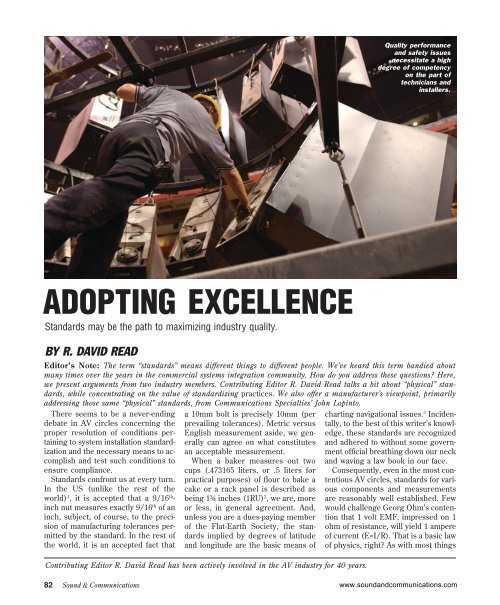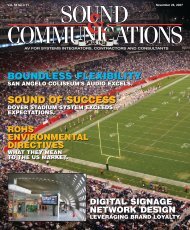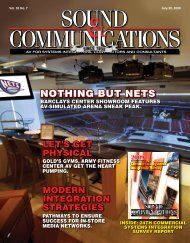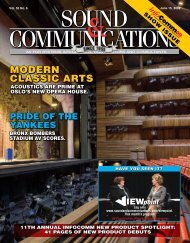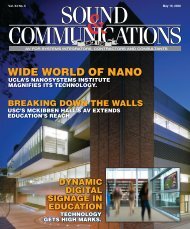Sound & Communications April 2008 issue
Sound & Communications April 2008 issue
Sound & Communications April 2008 issue
- No tags were found...
You also want an ePaper? Increase the reach of your titles
YUMPU automatically turns print PDFs into web optimized ePapers that Google loves.
Quality performance<br />
and safety <strong>issue</strong>s<br />
necessitate a high<br />
degree of competency<br />
on the part of<br />
technicians and<br />
installers.<br />
ADOPTING EXCELLENCE<br />
Standards may be the path to maximizing industry quality.<br />
BY R. DAVID READ<br />
Editor’s Note: The term “standards” means different things to different people. We’ve heard this term bandied about<br />
many times over the years in the commercial systems integration community. How do you address these questions Here,<br />
we present arguments from two industry members. Contributing Editor R. David Read talks a bit about “physical” standards,<br />
while concentrating on the value of standardizing practices. We also offer a manufacturer’s viewpoint, primarily<br />
addressing those same “physical” standards, from <strong>Communications</strong> Specialties’ John Lopinto.<br />
There seems to be a never-ending a 10mm bolt is precisely 10mm (per<br />
debate in AV circles concerning the prevailing tolerances). Metric versus<br />
proper resolution of conditions pertaining<br />
to system installation standarderally<br />
can agree on what constitutes<br />
English measurement aside, we genization<br />
and the necessary means to accomplish<br />
and test such conditions to When a baker measures out two<br />
an acceptable measurement.<br />
ensure compliance.<br />
cups (.473165 liters, or .5 liters for<br />
Standards confront us at every turn. practical purposes) of flour to bake a<br />
In the US (unlike the rest of the cake or a rack panel is described as<br />
world) 1 , it is accepted that a 9/16 th - being 1¾ inches (1RU) 2 , we are, more<br />
inch nut measures exactly 9/16 th of an or less, in general agreement. And,<br />
inch, subject, of course, to the precision<br />
of manufacturing tolerances per-<br />
of the Flat-Earth Society, the stan-<br />
unless you are a dues-paying member<br />
mitted by the standard. In the rest of dards implied by degrees of latitude<br />
the world, it is an accepted fact that and longitude are the basic means of<br />
Contributing Editor R. David Read has been actively involved in the AV industry for 40 years.<br />
charting navigational <strong>issue</strong>s. 3 Incidentally,<br />
to the best of this writer’s knowledge,<br />
these standards are recognized<br />
and adhered to without some government<br />
official breathing down our neck<br />
and waving a law book in our face.<br />
Consequently, even in the most contentious<br />
AV circles, standards for various<br />
components and measurements<br />
are reasonably well established. Few<br />
would challenge Georg Ohm’s contention<br />
that 1 volt EMF, impressed on 1<br />
ohm of resistance, will yield 1 ampere<br />
of current (E=I/R). That is a basic law<br />
of physics, right As with most things<br />
82 <strong>Sound</strong> & <strong>Communications</strong><br />
www.soundandcommunications.com


